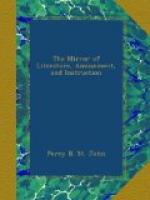Little is known of the schooldom of Scott, that denotes anything like precocious talent. It is, however better ascertained that his early rambles amidst the Tweed scenery retarded his educational pursuits. He received the rudiments of knowledge under the home tuition of his mother; next attended an ordinary school at Edinburgh, and was then placed at the High School, his name first appearing in the school register in the year 1779. His masters, Mr. Luke Fraser, and Dr. Adam, were erudite and pains-taking teachers; but, to borrow a phrase from Montaigne, they could neither lodge it with him, nor make him espouse it, and Chambers illustratively relates, “apparently, neither the care of the master, nor the inborn genius of the pupil, availed much in this case; for it is said that the twenty-fifth place was no uncommon situation in the class for the future Author of the Waverley Novels.” Perhaps the only anecdote of any early indication of talent that can be relied on is that related by Mr. Cunningham, of Burns:—“The poet, while at Professor Ferguson’s one day, was struck by some lines attached to a print of a Soldier dying in the snow, and inquired who was the author: none of the old or the learned spoke, when the future author of Marmion answered, ‘They are by Langhorne.’ Burns, fixing his large, bright eyes on the boy, and, striding up to him, said, it is no common course of reading which has taught you this—’this lad,’ said he to the company, will be heard of yet.”
At school, Sir Walter represents himself to have excelled in what may be termed the art, or, as Swift calls it, the “knack,” of narrating a story, which, by the way, is as companionable an acquirement at school as elsewhere. His account is as follows:—“I must refer to a very early period of my life, were I to point out my first achievements as a tale-teller—but I believe some of my old school-fellows can still bear witness that I had a distinguished character for that talent, at a time when the applause of my companions was my recompense for the disgraces and punishments which the future romance writer incurred for being idle himself, and keeping others idle, during hours that should have been employed on our tasks. The chief enjoyment of my holydays was to escape with a chosen friend, who had the same taste with myself, and alternately to recite to each other such wild adventures as we were able to devise. We told, each in turn, interminable tales of knight-errantry and battles and enchantments, which were continued from one day to another as opportunity offered, without our ever thinking of bringing them to a conclusion. As we observed a strict secresy on the subject of this intercourse, it acquired all the character of a concealed pleasure; and we used to select for the scenes of our indulgence, long walks through the solitary and romantic environs of Arthur’s Seat, Salisbury Crags, Braid Hills, and similar places in the vicinity of Edinburgh, and the recollection of those holydays still forms an oasis in the pilgrimage which I have to look back upon."[4]




